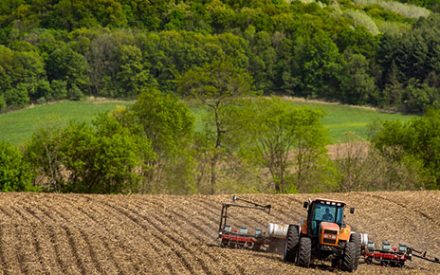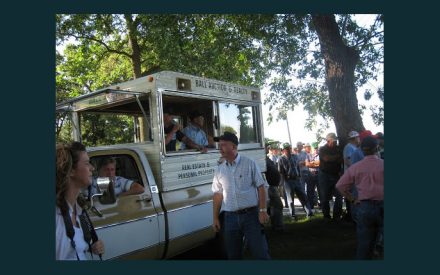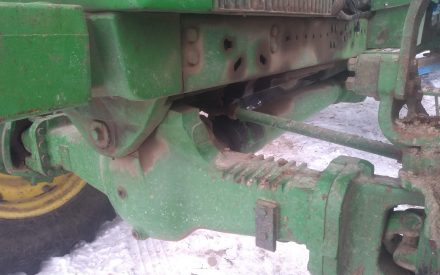Once you have a list of tasks and implements needed to perform those tasks, do some research on the minimum horsepower required to power those implements. Most small livestock farms can easily perform most tasks with an 85 power-take-off (PTO) horsepower tractor. A farm making hay into small square bales can easily make do with a 50 PTO horsepower tractor. If heavy tillage needs to be done requiring more horsepower, it may be advantageous for a farmer to hire a neighbor instead of keeping a large tractor around just to perform a couple hours of work each year. On the other hand, if you have a few acres of land to care for where tasks might include some mowing, hauling of feed for a few animals, or pulling a small utility wagon, a smaller compact utility tractor might take care of all of your needs.
Consider the number of hours a year that tractors and implements will be in operation. While you don’t want expensive machinery to sit idle you also don’t want to constantly operate a tractor that is underpowered for the tasks it’s performing to prematurely wear out.
The longer a tractor or an implement sits idle the more likely it is for it to deteriorate. Bearings will seize, oil pans and fuel tanks can collect water, battery cables will corrode, and tires will crack. The slow death of farm equipment is often caused by rust, corrosion, mice, rats, insects, and mold.
Case study – Scenario 1
Let’s assume you purchase 40 acres of pasture land, intending to custom graze cattle that are owned by a local farmer. The owner of the cattle will supply any hay needed to supplement your pasture in the event of a dry period. He makes hay in 1000 lb bales. Your farmstead has a concrete barnyard where you can feed and water the cattle and there is a gravel driveway entry to the barnyard. You’ve determined a tractor is necessary to care for the pasture and animals.

What do you need?
- A loader to offload a trailer and carry 1000 lb bales
- Mower to clip pasture
In this example, an open station, two-wheel drive tractor with ballasted rear tires will likely perform the tasks. You do not want a narrow front wheel-base or tricycle spacing that is common on older tractors. Given the number of hours a year this tractor will be used, you could purchase a gas powered tractor to help save money on the initial cost even though gasoline powered engines tend to burn more fuel under a load than diesel burning engines. The advantage that gasoline engines have over diesel is their ability to start without being plugged in during periods of cold weather. Gasoline engines do have disadvantages, including the need to replace and maintain parts like spark plugs, spark plug wires, caps, rotors, points, and carburetors.
Case Study – Scenario 2
Building on the first scenario, a neighboring farmer is retiring and has inquired if you would like to manage forty acres bordering your property. You agree to rent the property, and determine that growing forty acres of hay will fit in well with your business model. The neighboring farmer grew corn on this field last year.
What will you need to get a crop of hay started and harvested?
- Traction to pull a disk
- Horse power (HP) to pull a grain drill, cultipacker, mower conditioner and rake
- HP and hydraulic flow to run a round baler
The tractor you purchased in Scenario 1 was big enough to move bales and mow pasture but it will not have enough traction, HP, or hydraulic flow to run all the above implements efficiently or in a timely manner.

The retiring neighbor has agreed to prepare the land for planting and lend you his grain drill which your current tractor has enough HP to pull. You decide to keep your current tractor, but have identified a need for another tractor and a few implements to make hay more efficiently.
- A used nine foot disc mower conditioner can be obtained for $6500 and requires 80 HP PTO to operate
- You found a used twine wrap baler in good condition for $6000 but it requires hydraulic flow of at least 12 gallons per minute (GPM). The manufacturer recommends you have at least 65 PTO HP to operate the baler.
- You can rake hay with your current tractor.
Based on your implement needs, the minimum requirements of your second tractor are at least 80 PTO HP and 10 GPM hydraulic flow.
Case Study – Scenario 3
As time goes on the retired farmer next door inquires if you’d like to farm the rest of his land (200 acres) located 3 miles from your place. This opportunity offers you the ability to expand your operation from custom grazing to custom heifer raising on a year-round basis. The 200 acre farm has a barnyard with operational feeding equipment and two silos.
You decide to grow corn for silage to help meet the heifers’ nutritional needs during the winter months. You do the math and find that you only need to chop ten acres of corn silage to feed the cattle. A neighbor can be hired to plant and spray. Buying a new forage harvester is out of the question, so you check the used market for used equipment. You can find a used pull-behind type chopper for $2000 and two used chopper boxes for $5000. You can find a used forage blower to get the harvested silage into the silo for $500.
What will you need for this operation?
- HP for forage blower
- HP and traction for forage harvester
- Traction for pulling loaded wagons to the silo
- 3 tractors – one for each of these operations
You ask around and find that you can hire a neighbor to put up the corn silage for $75/acre if you provide the forage blower. He can drop the price to $45/acre if you provide some labor and a tractor.
You already know that going into custom heifer raising will require you to operate in all weather conditions including mud and snow. Your new venture will also require a 250 bushel or larger manure spreader, so you have prepared yourself to purchase a third tractor with at least 85 PTO HP and front wheel assist with a cab to accomplish this.
The resale value on your first tractor is minimal and it is still reliable so you decide that selling it to pay for your next tractor doesn’t make sense, so you opt to keep it as a chore tractor on your home place. You price out 85 PTO hp tractors with 12 GPM or more hydraulics, a cab and front wheel assist, and realize that they are too pricey for your budget. You do find an older 2-wheel drive tractor with cab and duals that match everything else you need for a reasonable price that won’t break your budget. You can run this tractor for now and eventually graduate to the model with front wheel assist when your budget allows for it.
Knowing that you will need to add a tractor anyway puts the spotlight on whether you will chop your own corn or hire the neighbor to do it. If you help and provide two tractors (one at the blower and one pulling loads) you can get the job done for $450/year without purchasing any extra equipment. Over seven years (the standard depreciation timeline for equipment), you will spend $3,150 in custom corn chopping. If you purchase the machines required to do the job yourself, your upfront cost will total $7500. Using your neighbor’s custom rate cost as a guideline for your own expenses to do the job yourself, it would take you almost 17 years to make up the cost of buying your own equipment. In this scenario it does not pay for you to add these extra machines to your fleet.
Considerations before purchasing equipment
These scenarios illustrate how prudent decision-making can save you money. Answer these questions before jumping to purchase equipment.
- What are the tasks that need to be performed?
- What tools/implements are necessary for accomplishing the work?
- What are the minimum horsepower requirements for those implements?
- What will owning those implements cost?
- What will owning the tractors with the minimum hp and features requirements cost?
- What would it cost to rent a tractor and implement for these tasks?
- How much does a custom operator charge to perform the same task?
- How many acres or number of head can this purchase be divided over?
- After dividing out the acres or number of head sold annually, will the costs of equipment and ownership be more or less than having a custom operator perform the tasks?
- If you need to finance the purchase will the cost added by the interest be more or less than having a custom operator perform those tasks?
- How much do you anticipate the regular maintenance will cost?
Always check with a local dealer on any financing deals they are offering on new equipment – you may find it’s more economical buying new with a low interest rate than buying used at a higher rate.

 Used tractors and machinery make work easier on farms and large properties
Used tractors and machinery make work easier on farms and large properties Tractor buyer be wary: sourcing used equipment online
Tractor buyer be wary: sourcing used equipment online Tractor buyer be wary: sourcing used equipment the old fashioned way
Tractor buyer be wary: sourcing used equipment the old fashioned way Plan for maintenance to avoid costly repairs with tractor ownership
Plan for maintenance to avoid costly repairs with tractor ownership


